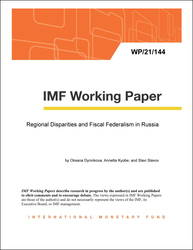
Regional Disparities and Fiscal Federalism in Russia
Regional Disparities and Fiscal Federalism in Russia
READ MORE...
Volume/Issue:
Volume 2021
Issue 144
Publication date: May 2021
ISBN: 9781513573649
$18.00
Add to Cart by clicking price of the language and format you'd like to purchase
Available Languages and Formats
| English |
Prices in red indicate formats that are not yet available but are forthcoming.
Topics covered in this book
This title contains information about the following subjects.
Click on a subject if you would like to see other titles with the same subjects.
Economics- Macroeconomics , Public Finance , Economics / General , International - Economics , risk sharing , Russia's system , transfers from the federal budget , complex system , inequality in Russia , Income , Income inequality , Disposable income , Fiscal federalism , Global
Summary
This paper examines how regional disparities have evolved in Russia and how Russia’s system of intergovernmental fiscal relations is managing these disparities. Regional disparities have fallen over the past two decades but remain relatively high. Socioeconomic outcomes remain worse in lagging regions despite faster growth and convergence in income levels. The twin shocks of COVID-19 and lower oil prices appear to have impacted richer regions disproportionately. Compared to other large countries with federal systems of government, Russia stands out with its high reliance on direct taxes as a revenue source for its regions. Transfers from the federal budget to the regions provide some redistribution by reducing the dispersion in real per capita fiscal spending, but also tend to be associated with lower growth. The Russian fiscal system offers degrees of redistribution and risk sharing of around 26 and 18 percent, respectively—with in-kind social transfers contributing the most. Finally, federal transfers in the aggregate tend to be procyclical and are also fairly unresponsive to shocks to regions’ own revenues.
Copyright © 2010 - 2025
Powered by:
AIDC



